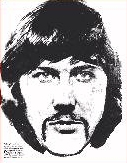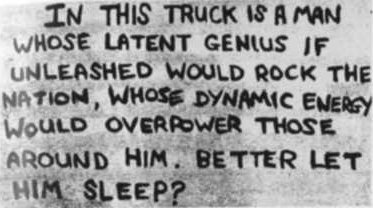
Peter Sutcliffe, The Yorkshire Ripper
The reign of terror by the man who became known as the Yorkshire Ripper began on 29 October 1975, with the murder of Wilma McCann, and ended on 2 January 1981, when Peter Sutcliffe was arrested in Sheffield with a prostitute who was almost certainly intended as his Fourteenth murder victim.
The attacks on Yorkshire women began on 5 July 1975, when a woman named Anna Rogulskyj was struck on the head with a hammer. On 15 August Olive smelt was knocked unconscious by a hammer blow from behind. The attacker slashed both women - Mrs. Smelt’s buttocks were cut. Both recovered after brain surgery.

On 29 October Wilma McCann, a Scotswoman who had separated from her husband and taken to prostitution, left four children to go on a pub crawl in Leeds. In the early hours of the following morning, she was struck on the head from behind with a ball-headed hammer, then dragged into a playing field. Here the killer pulled up her dress, and inflicted injuries on the stomach, chest and in the genital area with a knife and, possibly, other tools.
From then on, the murders followed in regular succession. The rippers next victim was Emily Jackson who was killed on 20 January 1976 in Leeds.
More than a year passed before the Ripper struck again. Irene Richardson was his next victim. Her body was found on the 6 February near a sports pavilion.
The Ripper claimed a few more girls in the on going months when on the 1 October he encountered a twenty-year-old Scots girl, Jean Jordan, and took her to the Southern Cemetery. There he killed her with exceptional violence, stripping her naked and mutilating the body. The body was not found until nine days later, when the medical examination revealed that the murderer had killed her with eleven blows to the head, and stabbed her twenty-four times.
In this case, the police at last found a clue. In Jean Jordan’s handbag there was a new five pound note, which had been issued at Shipley, Yorkshire, only four days before the murder. It seemed probable that the killer had handed it to her. The police traced the batch of notes to the depot where Sutcliffe worked as a lorry-driver, and questioned him. Since there appeared to be no evidence to connect him with the murders, he was cleared.
By early 1978 the hunt for the Ripper had become one of the largest police operations ever mounted in northern England. George Oldfield, the assistant chief constable in charge of the case, gave colleagues the impression that his search for the Ripper had become a personal crusade. Police work on the case was exhaustive; the police were willing to pursue any lead, no matter how tenuous.
The Ripper decided to move to Huddersfield to find his next victim, he felt that police activity in Leeds was becoming too intensive.
In 1978 and 1979 the police had received three letters signed ‘Jack the Ripper’ threatening more murders. Then on 26 June 1979 the police received a cassette - addressed in the same handwriting as the three letters - containing the voice of the Ripper. Speaking with a slow Geordie accent, obviously reading aloud, the voice taunted
George Oldfield for failing to catch him: ‘You can’t be much good, can you?’ He promised to strike again, and warned that if the police got too close he would probably ‘top’ himself (commit suicide). The tape was treated seriously - although after Sutcliffe’s arrest it became clear that both tape and letters were from a hoaxer - and the police wasted much time looking for the letter-writer in the Wearside area. In July George Oldfield became ill from overwork on the case, and suffered a heart attack.
On 20 August 1979 the Ripper killed Marguerite Walls by strangling her with a piece of rope (Sutcliffe later explained that he did not have his knife with him).
His next two victims survived; Dr. Upadhya Bandara whom he assaulted then later claimed to have apologised to and left her; and sixteen-year-old Theresa Sykes near her home in Huddersfield. Her boyfriend heard her screams and ran to her aid. The Ripper had knocked her to the ground, but he ran away.
Possibly it was this close shave with capture that made Sutcliffe decide to lie low for a while. His final murder took place more than a year later. On 17 November 1980 he killed a twenty-year-old Leeds student.
The Yorkshire Ripper was finally caught on 2 January 1981. Police surveillance of prostitutes and their clients paid off. Sergeant Robert Ring and PC Robert Hydes recognised 24-year-old Olive Reivers while on patrol. She and Sutcliffe were in a parked car down in Melbourne Lane. Olive had been cautioned for prostitution before and had a forthcoming court appearance for another offence. Sutcliffe’s story was that he was "Peter Williams" and he was just out with his girlfriend. The police weren’t convinced and checked the plates on the car which proved to be stolen. Sutcliffe asked if he could get out to urinate and Hydes gave permission; Sutcliffe stood by an oil storage tank a few feet away, then got back into the car. He was then taken back to the police station for questioning, Sutcliffe again asked to go to the lavatory and was given permission. When the police searched him they found a length of clothesline on him. It made police begin to think that they might have caught Britain’s most wanted man.

It was the following day that Sergeant Ring learned about Sutcliffe’s brief absence from the car to relieve himself, and went to look near the oil storage tank. In the leaves, he found a ball-headed hammer and a knife. Then he recalled Sutcliffe’s trip to the lavatory at the police station. In the cistern he found a second knife. When Sutcliffe was told that he was in serious trouble, he suddenly admitted that he was the Ripper, and confessed to the murders.
They found out that the mans real name was Peter Sutcliffe who was a lorry-driver and married to a Czech woman. Sutcliffe was formerly employed as a grave digger, and claimed that gods voice emanated from a grave and ordered him to kill prostitutes.
Sutcliffe’s trial began on 5 May 1981. He had pleaded not guilty to murder on grounds of diminished responsibility, and told the story of his ‘mission’ from god. On 22 May Sutcliffe was found guilty of murder, and jailed for life, with recommendation that he should serve at least thirty years.
Go back